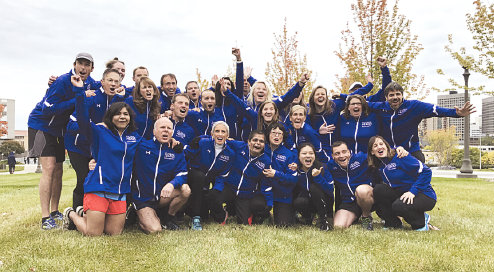Get rid of the shaking
By Liu Zhihua ( China Daily ) Updated: 2016-11-05 10:52:03
 |
|
Chu poses with fellow runners. [Photo provided to China Daily] |
The global program, which has been in operation since 2006, annually selects 25 long-distance runners who suffer from the disease but are benefiting from medical technology, to represent their countries to run the marathon event in Minnesota, in the US.
"Through running the marathon I hope to make more people aware about essential tremor, and I hope to prove that you can enjoy a normal life with proper treatment," says Chu.
Her story goes back almost 10 years when her hands started shaking a little. She then attributed this to overwork and fatigue, and didn't pay much attention to it.
But as the shaking occurred more often, once even during a dinner when she found herself unable to pour baijiu into other people's cups. She also found that she could not write properly, or cut nails, and finally decided to seek medical help.
Her doctor then diagnosed her with Parkinson's disease and prescribed medication that had no effect.
As her condition worsened she went to another hospital where a doctor suspected she had essential tremor and suggested she visit the Beijing Xuanwu Hospital.
At Xuanwu Hospital, one of China's top facilities for Neuroscience and Gerontology, Chu was finally diagnosed with essential tremor.
However, despite the delays, Chu is relatively lucky when compared with most other patients.
Most of the others typically go through up to between 10 and 15 incorrect diagnoses before finally being diagnosed with essential tremor, say experts.
That is because doctors in smaller towns are not aware of the disease, and also because it is very tough to distinguish between essential tremor and Parkinson's disease, especially in the early stages, says Li.
Neither blood tests nor medical imaging can help diagnose essential tremor, and the diagnosis typically is based on the doctor's observation of the patient, and the way the patient responds to medication, says Li.
For instance, he says, Parkinson's patients tremble all the time, and often the tremors are accompanied by other symptoms, such as stiffness and sluggishness in movement. On the other hand, those suffering from essential tremor, especially in the early stages, shake only when in motion, he says, adding that sometimes patients can have both the diseases at the same time.
As for treatment, the disease is not curable, but can be controlled and managed with proper medical intervention. The problem, however, is that many patients do not understand the condition and are reluctant to accept medical intervention.
|
|
|
|
|
|
|
|

























 Raymond Zhou:
Raymond Zhou: Pauline D Loh:
Pauline D Loh: Hot Pot
Hot Pot Eco China
Eco China China Dream
China Dream China Face
China Face






